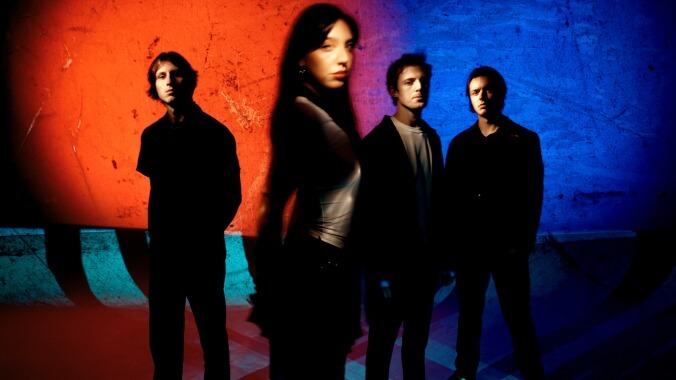The Mysterines Embrace the Next Day
Lia Metcalfe and Paul Crilly talk about how their Liverpool band found inspiration in American music scenes, working with John Congleton, tricking their bandmates, and their sophomore album, Afraid of Tomorrows.
Photo by Steve Gullick
While I was still in college, I would hop on the college radio station airwaves every week with my newest finds. One band that would constantly find their way onto my playlist was Liverpool’s most ferocious young act, the Mysterines, and, thanks to Spotify autoplay, I stumbled across their angsty Love’s Not Enough EP while listening to Wolf Alice (a similarly searing English rock act). Since then, I haven’t been able to get enough of Lia Metcalfe’s raspy yet fearsome vocals and her band’s brilliantly noisy alt-rock sound.
The Mysterines began when vocalist and frontwoman Metcalfe met bassist George Favager while they were living near each other on the Wirral Peninsula. Then, in 2020, the pair added guitarist Callum Thompson and drummer Paul Crilly to form the lineup behind their debut album Reeling, an explosive, angsty display of grunge rock. After two years of touring around the globe with the Arctic Monkeys, hitting the festival circuit and becoming a more mature and self-assured version of themselves, they are delivering an album self-described as “whimsical surreal,” cutting the strings between them and their past: Afraid of Tomorrows.
After Metcalfe and I spend time gushing over David Lynch’s bizarre yet affecting art—a massive inspiration for Afraid of Tomorrows—and chatting about memoirs, she and Crilly explain why they felt an earnest desire to set their grunge past ablaze and search for a new sound that felt more in tune with where they are now. “It was a refresh to try and find that spark with creating again,” Metcalfe says. “I think if you stick to the same thing over and over again, it becomes a bit tedious. So ripping that whole thing up and injecting in more of what we were listening to and expand on it.” “I think that was the initial idea to start writing the album. It was quite an intimidating thing, but it was quite exciting, too,” Crilly adds. “We just needed to do something that excited us again, whether that was a hip-hop album or heavy metal.”
To block out the noise of Liverpool and decompress from the excitement of playing for packed venues, the band took a tour across the English countryside, doing isolated writing in barns and small towns, like Hexham, to hone their new sound. “It was quite fun, to be honest. But neither Lia nor I drive, so we’d get dropped off there, and we’d be stranded,” Crilly laughs. In these secluded writing sessions, the band wrote more collaboratively than they had on Reeling—most of which was written when the world was in lockdown—and brought in a multitude of influences.
The Mysterines turned to their favorite bands from their teens to draw some musical inspiration. “We watched the Meet Me in the Bathroom documentary, which is about the era of the New York scene of the Walkmen, LCD Soundsystem and The Yeah Yeah Yeahs,” Metcalfe says. “That was a huge inspiration for us to watch those bands on their journeys. That whole scene was pretty inspiring for the record.” Tracks like “Another Another Another” and “Tired Animal” show off the electro-rock blend of LCD Soundsystem, while “Hawkmoon” brings in dramatic synths and powerful vocals that beckon the work of the Yeah Yeah Yeahs—along with a David Cronenberg reference to boot.
The NYC explosion at the turn of the new millennium wasn’t the only place the band went looking for creative inspiration. Metcalfe found some insight in Billie Holiday’s autobiography as well. “I remember I finished a Leonard Cohen book and saw [Lady Sings the Blues] on the bookshelf, and it just kept calling out to me,” she says. “Her story is incredible. I’ve loved many singers of that era for a long time, but I had never really delved into Billie Holiday, though I was aware of Strange Fruit. Her story is so unbelievable and heartbreaking that it sometimes felt like a fictional book, but obviously, it happened. It’s also written in her dialect, which is cool because you read it in her voice, and you become so intimate with her as an artist. Everyone should read it, to be honest, especially female musicians, because not only does it show how far we’ve come, but it shows how far we’ve still yet to go.”
-

-

-

-

-

-

-

-

-

-

-

-

-

-

-

-

-

-

-

-

-

-

-

-

-

-

-

-

-

-

-

-

-

-

-

-

-

-

-

-








































